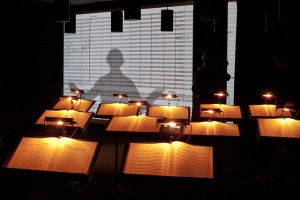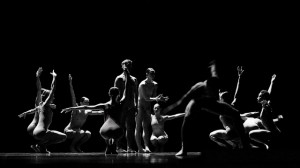With Donna dancing and Katherine making music, the following duet presents a bi-disciplinary reflection on the complexity of the performing arts in higher education and their connection to the Humanities as a way of thinking, studying, and experiencing the world. But first we take a peek backstage.
STAGE PREP

As if art were ice cream, arts criticism is often reduced by the public to mere taste and personal opinion–liking or not liking. While a shallow focus on personal gratification may depress, or even repress, arts scholars particularly, it signifies a reality that is shared by many Humanities professors. We find ourselves in an era in which human experience and cultural discord are far less important than the acquisition of wealth and power, when winning trumps caring, when selling exceeds giving, and factual sources supersede social and moral conundrums. As digital technologies bring global injustices closer to the public and to the attention of responsible educators, we need the Humanities to sustain our souls and to understand how we got here.
To delve into the Humanities is to engage the complexities of language and culture, religions, philosophies, histories, and metaphors of meaning connecting all of those domains. Far beyond the limiting stereotypes of music and dance in education, Katherine and Donna find themselves immersed in side-by-side disciplines, indulging in the rigors of their fields—theories and techniques, perspectives and rules, judgments and interpretations. As performing arts doctors in the Humanities, we need not join public arts advocacy that spins arts education into a vocational enterprise leading to marketable qualifications. Development of the thinking mind and body, the ethical self, and the creative impulse is invaluable education any way it happens.
MUSIC PRELUDE
I enjoyed my years as a graduate student in musicology, studying the discipline’s history, theory, criticism, and aesthetics. I particularly liked learning about the nature and meaning of beauty, and examining relationships between music and our broader cultural history. Nevertheless, as time went on, the work felt increasingly text-driven, removed from the art form that it was intended to illuminate. Seeking to reconnect to sounding music, I eventually joined my school’s (mostly undergraduate) university orchestra. This was a low-pressure ensemble of amateur musicians who wished to maintain a skillset, diversify a resume, or, like me, offset the demanding and sometimes isolating work that formed the core of their college experience. In my case, however, I discovered deep connections between performance and scholarship, and in them, new dimensions to my research. My years playing in the orchestra taught me that the rhetorical distinctions between Arts and Humanities, performance and scholarship (and, perhaps on a broader level, body and mind) are, in many ways, superficial and misleading.

Now, as a musicologist and music professor at a private liberal arts college, I center my teaching of music history on the interdependence of scholarship and performance. The performances that I have engineered mark the meeting place of the past and the present, the body and the mind, the arts and the sciences. Performance, as a product of this union, thus becomes the fullest expression of the Humanities, reflecting interdisciplinarity, critical thinking, an historical mindset, and an ethical worldview.
I offer, as an example of the richness of performance studies and their relationship to the Humanities, the thirteenth-century chanson that we sang in my music history course last fall. As with any good vocal performance, we began our preparation with Textual Criticism. In the text, we found characteristic traits of courtly love, and we examined its manifestation in the context of thirteenth-century court poetry in general. Focusing now on History, we contextualized the love story with our knowledge of broader contemporary tensions related to the Feudal system and concomitant class conflicts. The text further invited engagement with Gender Studies, as we considered the latent misogyny in the poet’s despair of women, and observed the relationship between desiring a woman and objectifying her that pervades so much popular culture today. Turning next to Music Theory, we analyzed the archaic, pre-tonal musical language of the piece, and grappled with the various ambiguities of the notation. These ambiguities inevitably turned our work toward Social Anthropology, as we tracked our understanding of complex interactions between orality and literacy in this period, and analyzed the piece for markers of one or the other.
As we continued on this intellectual journey, we were met with another conundrum: Evidence suggested that our piece may have been accompanied by instruments, which led to the consideration of acoustical and physical properties of thirteenth-century instruments, themselves. Drawing on basic Physics, we considered physical properties of gut versus steel strings, plucked versus hammered keys, and wood versus metal pipes. As this suggests, we wanted to be as historically accurate as possible, but we also wanted to create something meaningful. Aesthetics became our focus as we practiced the melody’s delicate ornaments and undulating slurs to achieve the desired effect. Drawing on Music Criticism, we next considered the interpretations of our piece from prominent recordings, and we marveled at the ways in which historically informed performance is so often utterly “modern.” Lastly, we embarked on our own Performance, bringing to life our technical, intellectual, and artistic considerations. In that experience, we were performers, but we were also linguists, critics, historians, humanists, theorists, anthropologists, physicists, and aestheticians. We were artists and students, bringing history vividly and meaningfully into the present.
DANCE MOVES IN
Nearly two decades ago, dance professors at Hobart and William Smith Colleges made an argument to the Committee on Academic Affairs, that the Dance Ensemble course should earn students full credit, just as any other academic course. This was a simple argument to make, and at our progressive liberal arts college the proposal passed the first time. What is perplexing still is how foreign the argument is—how little most academic communities know or care about why a dance ensemble course is a multi-faceted academic experience. The answer represents the implicit value of the performing arts as Humanities in higher education.
A dance ensemble course involves the creation of contemporary choreography by a dance professor in collaboration with a group of students from myriad academic majors who were selected by audition to perform a new piece in the spring concert. So far it sounds stereotypical … we audition and choose dancers, teach choreography, rehearse, then perform. Indeed, to reach high standards of performance, students must practice with discipline, employ technical skills, and display performance abilities. But this is only half the story. The other half comprises critical thinking, humbling analysis, mediation of aesthetic perspectives, kinesthetic empathy, retention of corrections, and creative contributions, to name a few necessary components of the student experience. While students are required to read and write during the course, these traditional components do not become the sole academic portion. The development of the thinking mind and body, the ethical self, and the creative impulse comprise their Humanities education.

Dag in de Branding 25 & Together Now – Nederlands Dans Theater – Chamber, Photographed by Maurice (CC License)
The choreographer starts from scratch with merely a concept, music possibilities, and a few gestures that evoke the concept she is attempting to convey through movement. The students’ bodies and their individual expressions become the art that reveals humanity. Trial and error, setting and revising, testing and re-doing, experimenting and discovering… these mechanisms demand tolerance for ambiguity and faith in the creative process. Students must possess dance and music literacy, or they struggle with its absence, unable to read an evolving narrative. The editorial process relies on students’ ability to realize what movement to keep and why, which spatial relationships reflect the theme of the piece and how, which relationships among dancers underscore the theme and when, and which parts of the dance to discard or re-choreograph. The questions and doubts are endless. Talking is as much a part of the rehearsal as dancing. New choreography never feels finished.
PERFORMANCE NOTES
This bi-disciplinary duet illustrates how the performing arts can realize fundamental goals of the Humanities—by fostering interdisciplinarity, critical thinking, self-reflection, abstract reasoning, and problem solving. The performing arts, as depicted here, challenge the false dichotomy between technical mastery of the body and higher level thinking of the mind, as well as the opposition between a critical engagement with history and the ephemeral, fleeting present. A successful performance, after all, reimagines and reconceives the past in the present. From this perspective, the commonplace pairing of “arts and humanities” needs revising. Our duet explores the arts as humanities—indeed, as emblematic of the Humanities tradition and values. The performing arts on college campuses engage the thinking minds and bodies of young adults, their ethical selves, and their creative impulses … making art and expressing humanity; this is education. And it will never be obsolete.
Donna Davenport and Katherine Walker, on behalf of the NY6ThinkTank